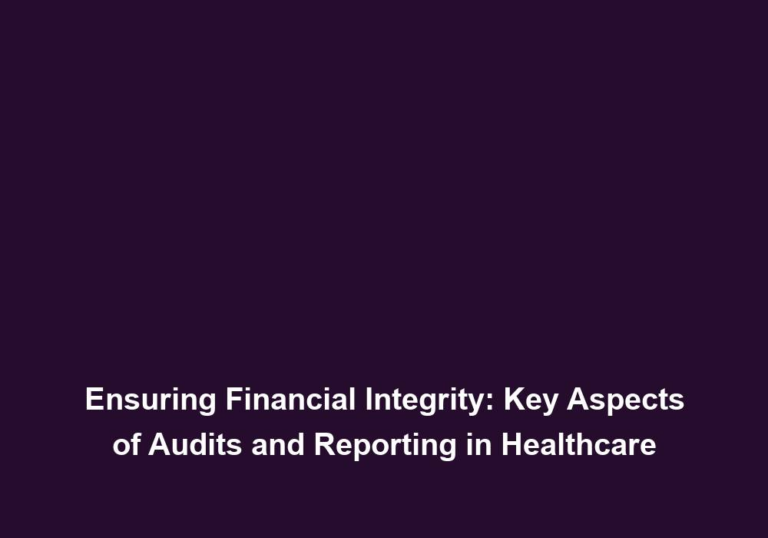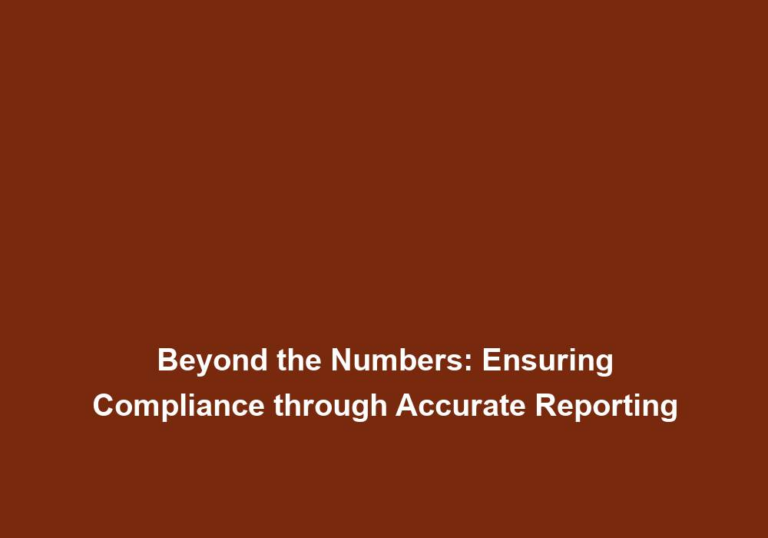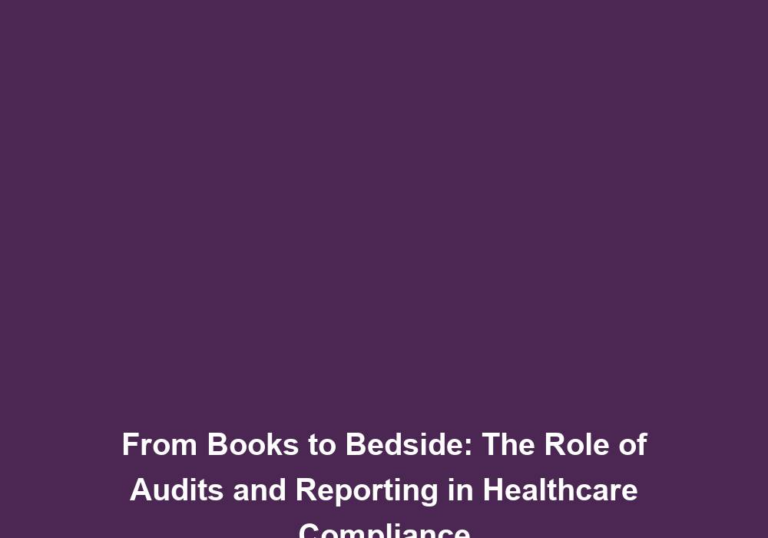Transparent Transactions: Key Elements of Compliance Reporting in the Medical Realm
In the medical industry, transparency is crucial, especially in financial transactions. Compliance reporting plays a vital role in ensuring that healthcare organizations maintain the highest standards of integrity and accountability. This article will delve into the key elements of compliance reporting in the medical realm, shedding light on the importance of transparent transactions.
Why is Compliance Reporting Essential in the Medical Realm?
- Preventing Fraud and Abuse: Compliance reporting serves as a vital tool in identifying and preventing fraudulent activities within the medical realm. By monitoring financial transactions, healthcare organizations can detect any suspicious behavior, such as billing irregularities or kickback schemes.
- Healthcare organizations must establish robust systems to monitor financial transactions effectively. This includes implementing advanced tools and techniques for data analysis, enabling the identification of patterns or anomalies that may indicate potential fraud or non-compliance.
- By promptly addressing red flags identified through compliance reporting, healthcare organizations can mitigate financial losses and protect themselves and their patients from the detrimental effects of fraudulent activities.
- Regular communication with external entities, such as auditors and regulators, helps healthcare organizations stay updated with industry best practices for fraud prevention.
- Maintaining Regulatory Compliance: The healthcare industry is heavily regulated, with numerous laws and regulations governing financial transactions. Compliance reporting helps healthcare organizations adhere to these regulations, ensuring that they stay in compliance with laws such as the Health Insurance Portability and Accountability Act (HIPAA) and the Anti-Kickback Statute.
- Accurate documentation of financial transactions is crucial for regulatory compliance. Healthcare organizations must maintain detailed records of invoices, receipts, contracts, and other relevant documents.
- Regular audits, conducted as part of internal controls and auditing processes, help identify any discrepancies and reinforce transparency. These audits ensure that financial transactions are conducted in accordance with established policies and procedures.
- Compliance reporting practices should be aligned with the evolving compliance regulations in the medical realm. Ongoing training and education programs for employees help keep them informed about the latest compliance requirements.
- Protecting Patient Privacy and Data Security: Compliance reporting also plays a crucial role in safeguarding patient privacy and data security. It helps healthcare organizations monitor access to patient records, ensuring that only authorized personnel can view and manipulate sensitive information.
- Healthcare organizations must implement strict protocols and access controls to protect patient privacy and data security. Compliance reporting helps identify any unauthorized access or manipulation of patient records.
- By leveraging advanced data analysis tools, healthcare organizations can detect any unusual patterns in access to patient records, helping identify potential breaches and take prompt action to mitigate risks.
- Regular training programs on compliance reporting and data security practices should be provided to employees to ensure they understand the importance of protecting patient information.
Key Elements of Compliance Reporting in the Medical Realm
- Accurate Documentation of Financial Transactions: Healthcare organizations must maintain accurate and detailed records of all financial transactions. This includes invoices, receipts, contracts, and any other relevant documents. Accurate documentation facilitates transparency and allows for easy tracking and auditing of financial activities.
- Accurate documentation is the backbone of compliance reporting, enabling healthcare organizations to provide evidence of financial transactions and ensure transparency.
- Detailed records should include information such as date, amount, purpose, and parties involved in the financial transactions. This level of detail aids in tracking and auditing financial activities effectively.
- Healthcare organizations should establish standardized procedures for documenting financial transactions to ensure consistency and accuracy.
- Internal Controls and Auditing Processes: Implementing robust internal controls and auditing processes is essential for effective compliance reporting. These controls ensure that financial transactions are conducted in accordance with established policies and procedures, minimizing the risk of errors or fraudulent activities. Regular audits help identify any discrepancies and reinforce transparency.
- Internal controls should include segregation of duties, where different individuals are responsible for initiating, approving, and recording financial transactions. This helps prevent collusion and reduces the risk of fraudulent activities.
- Auditing processes should be conducted by independent internal or external auditors to ensure objectivity and accuracy. These audits should cover all aspects of financial transactions, including revenue, expenses, and assets.
- Regular reviews of internal controls and auditing processes help identify any weaknesses or gaps in compliance reporting practices, allowing for timely improvements.
- Training and Education: Ensuring that employees are well-informed and trained on compliance reporting practices is crucial. Healthcare organizations should provide comprehensive training programs to educate employees on the importance of transparent transactions, regulatory compliance, and the detection of fraudulent activities. Ongoing education helps keep employees up-to-date with evolving compliance regulations.
- Training programs should cover topics such as regulatory requirements, ethical standards, and reporting procedures. Employees should be made aware of the consequences of non-compliance and the role they play in maintaining transparent transactions.
- Regular refresher courses and updates on compliance reporting practices should be provided to employees to ensure they stay informed about any changes in regulations.
- Healthcare organizations should encourage employees to ask questions and seek clarification on compliance reporting practices to foster a culture of continuous learning and improvement.
- Whistleblower Protections: Establishing mechanisms to encourage and protect whistleblowers is essential for effective compliance reporting. Healthcare organizations should have clear policies in place that protect employees who report any suspected non-compliance or fraudulent activities. This fosters a culture of transparency and encourages employees to come forward with any concerns.
- Whistleblower policies should provide assurances of confidentiality and protection against retaliation for employees who report suspected non-compliance or fraudulent activities.
- Healthcare organizations should establish anonymous reporting channels, such as hotlines or online portals, to facilitate the reporting of concerns.
- Regular communication and awareness campaigns should be conducted to educate employees about the importance of reporting potential non-compliance or fraudulent activities.
- Data Analysis and Monitoring: Utilizing advanced data analysis tools and techniques can greatly enhance compliance reporting. By analyzing financial data, healthcare organizations can detect patterns or anomalies that may indicate potential non-compliance or fraudulent activities. Continuous monitoring of financial transactions provides real-time insights and enables prompt action.
- Data analysis tools can help healthcare organizations identify unusual trends or outliers in financial transactions, enabling them to proactively investigate potential non-compliance or fraudulent activities.
- Continuous monitoring of financial transactions, with the help of automated systems, ensures real-time insights and alerts for any suspicious behavior.
- Regular data analysis reports and dashboards should be generated to provide management with a comprehensive view of compliance reporting activities and any identified risks.
- Collaboration with External Entities: Healthcare organizations should establish collaborative relationships with external entities, such as insurance providers, auditors, and regulators. Regular communication and sharing of information help identify best practices, ensure compliance with industry standards, and foster a culture of transparency.
- Collaboration with external entities allows healthcare organizations to stay updated with the latest regulatory requirements and industry trends.
- Regular meetings and discussions with external entities provide opportunities to share experiences and learn from each other’s compliance reporting practices.
- Healthcare organizations should actively participate in industry forums, conferences, and training sessions to enhance their knowledge and network with experts in compliance reporting.
Benefits of Transparent Transactions and Effective Compliance Reporting
-
Enhanced Trust: Transparent transactions and robust compliance reporting build trust among patients, employees, and stakeholders. When healthcare organizations demonstrate accountability and integrity in their financial practices, they establish a reputation for being trustworthy and reliable.
-
Mitigation of Legal and Financial Risks: By complying with regulations and maintaining transparent transactions, healthcare organizations can mitigate legal and financial risks. Non-compliance can lead to severe penalties, reputational damage, and even legal consequences. Effective compliance reporting helps identify and address potential risks before they escalate.
-
Improved Operational Efficiency: Transparent transactions facilitate smoother operations within healthcare organizations. Accurate documentation, streamlined financial processes, and adherence to compliance regulations contribute to improved efficiency and reduced administrative burden.
-
Protection Against Fraud and Abuse: Effective compliance reporting acts as a proactive defense against fraud and abuse. By identifying potential red flags and promptly addressing them, healthcare organizations can prevent financial losses and protect themselves and their patients from the detrimental effects of fraudulent activities.
In conclusion, compliance reporting in the medical realm is essential to maintain transparency, prevent fraud, and ensure regulatory compliance. By focusing on key elements such as accurate documentation, internal controls, training, data analysis, and collaboration, healthcare organizations can establish a culture of transparency and accountability. Through effective compliance reporting, they can enhance trust, mitigate risks, improve operational efficiency, and protect against fraud and abuse. Ultimately, prioritizing transparent transactions benefits both healthcare organizations and the patients they serve.







